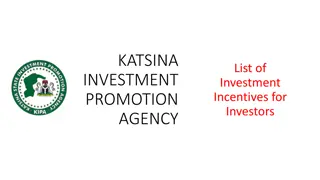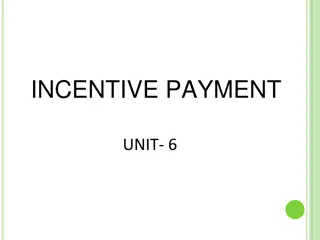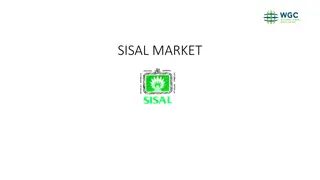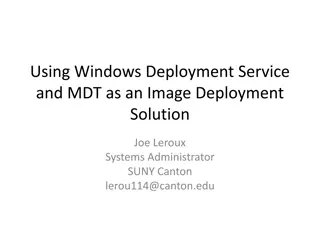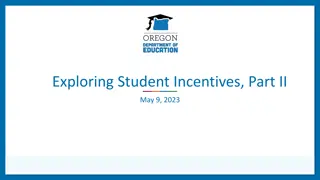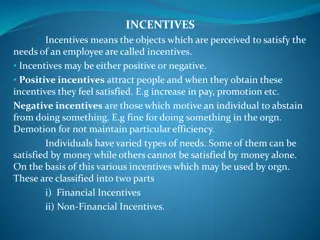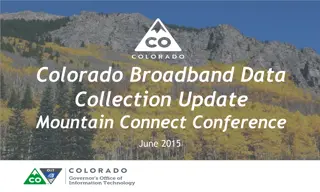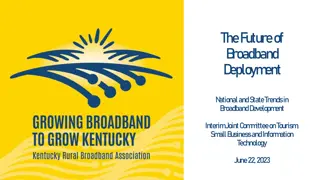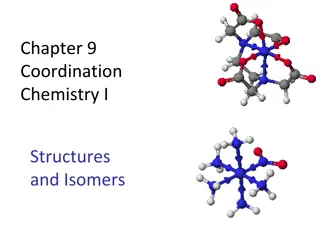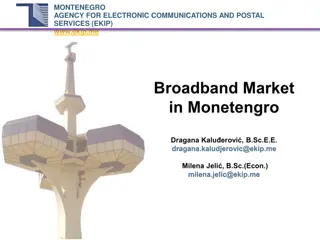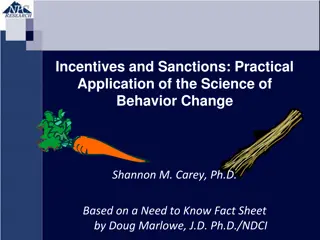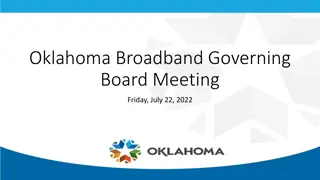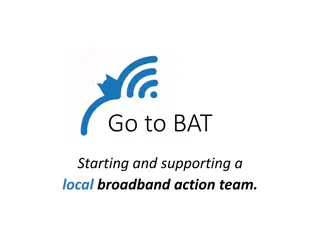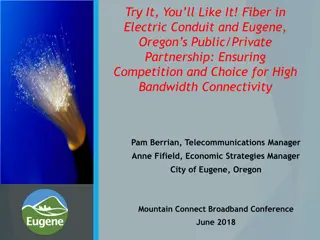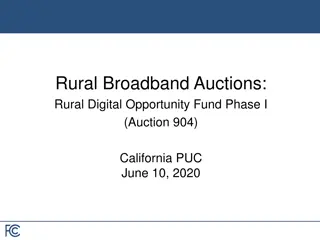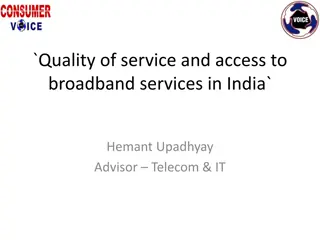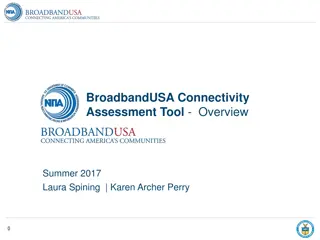Incentives for Broadband Deployment and Coordination in Brazil
Brazil's efforts in promoting sustainable development through broadband deployment, public-private sector coordination, reducing poverty, and fostering social development. Anatel's role, telecom sector restructuring, and the country's progress in expanding telecom access are highlighted.
Download Presentation

Please find below an Image/Link to download the presentation.
The content on the website is provided AS IS for your information and personal use only. It may not be sold, licensed, or shared on other websites without obtaining consent from the author.If you encounter any issues during the download, it is possible that the publisher has removed the file from their server.
You are allowed to download the files provided on this website for personal or commercial use, subject to the condition that they are used lawfully. All files are the property of their respective owners.
The content on the website is provided AS IS for your information and personal use only. It may not be sold, licensed, or shared on other websites without obtaining consent from the author.
E N D
Presentation Transcript
INCENTIVES FOR BROADBAND INCENTIVES FOR BROADBAND DEPLOYMENT AND DEPLOYMENT AND COORDINATION OF PUBLIC COORDINATION OF PUBLIC AND PRIVATE SECTORS TO AND PRIVATE SECTORS TO PROMOTE SUSTAINABLE PROMOTE SUSTAINABLE DEVELOPMENT DEVELOPMENT Jo o Batista de Rezende President, Anatel Brazil Rio de Janeiro, June 2012
Summary Brazil: a favorable moment National market figures Regulatory agenda
Brazil: a favorable moment Sustainable development Reduction of poverty Reduction of deforestation and increase in the use of green technologies Sustained economic growth Dynamic internal market, resilient to the economic crisis Important international player for foreign investments Public and private sectors investment From the Ministry of Planning, Budget and Management
Social Development Due to sound public policies, Brazil has been able to reduce social and regional inequalities, expand consumer market and support investment and innovation Brand new consumers!
Social Development From 2003 to 2009, about 29 million people joined middle class (C class). 7 million people climbed to the upper class. A and B classes will rise 40% till 2014 reaching more 11 million people. 2003 2014 2009 Source: exame magazine, FGV Rio, Cognatis Geomarketing, IPC editor
Anatel Created by the General Telecommunications Law 1997 Recent initiatives on transparency and accountability New means of public interaction through social media Board s open meetings Restructuring of the Agency
TelecomUsers The restructuring of the sector (1996) and the privatization of the state-owned Telebr s (1998) system brought competition and a set of universal service targets increasing telecom access to every municipality in the country, reaching all the corners of the immense Brazilian territory. 242 43 16,5 37,4 12,8 28,7 3,6 0,4 2001 2001 2011 2011 2001 2011 2001 2011 Broadband Pay-TV Mobile Fixed Source: Anatel. Million users
Internet service providers MARKET SHARE In a growing broadband market, companies are moving fast in order to offer bundle of services. The importance of this movement is easily observed in the chart below. The level of competition is likely to increase adding value and bringing benefits such as lower prices, improve the quality of services and better consumer relation. 29,7% 25,8% 22% 9,1% 1,7% 2011 Source: Teleco
Internet speed and household access in Brazil Numerous issues are contributing for the growth of Internet users in Brazil with faster speeds, such as middle class consumption, lower prices of devices and services, easier retail financing, better perception of the Internet connection as an important tool for education, access to information, leisure, communication. 2008 2009 2010 15% 9% 20% > 2Mbps 85% 91% 80% 2Mbps 24% 27% 18% Households connected
National Broadband Program (PNBL) The National Broadband Program was created by Decree N . 7175 of May 12, 2010. The objective of this program is to expand the infrastructure and telecommunications services, promoting access by the public and seeking the best possible price, coverage and quality. The goal is to provide broadband access to 40 million Brazilian households by 2014 at a speed of at least 1 Mbps. The Oi, Sercomtel and Telefonica) have signed terms of engagement to offer connections of 1Mbps for R$ 35.00 per month. Ministry of Communications, Anatel and fixed phone companies (CTBC, Furthermore, prices and conditions were established to offer wholesale capacity to small providers and municipalities. By the end of the year, the PNBL service plan will be available in 1,200 cities. At the end of 2013 there will be 3,300 cities served. Finally, in December 2014, connections of 1Mbps for R$ 35.00 will be available in 4,668 cities.
Amazon Region Unasur project to build a fiber optic ring to connect the South American countries. The Ministry of Communications is leading the project. The estimate costs for the first connections between the countries is US$ 100 million for 2000 km of fiber optic networks 11
Services to rural areas Ensuring telecom services in rural areas of Brazil, where 16% of population reside (30 million inhabitants), is a challenge In June 2011 we will auction the frequency of 450 MHz to carry voice and data services for rural areas Jointly auctioned with 4G (2,5 GHz). Possibility of use for green applications 12
4G In 12 of June Anatel sold the 2.5 GHz spectrum band for 4G services and the 450 MHz for rural services Companies VIVO, TIM, CLARO and OI will have to offer the 4G services acoording to the schedule below: Date Coverage ALL cities of the Confederation sCup 2013 April 2013 ALL cities of the World Cup 2014 December 2013 ALL the cities with more than 500k inhabitants May 2014 ALL the cities with more than 200k inhabitants December 2015 ALL the cities with more than 100k inhabitants December 2016 At least one operator in ALL the cities with more than 30K inhabitants December 2017 13
4G Also, the 3G coverage should be expanded according to the following schedule: Date Cobertura At least 30% of cities below 30k inhabitants. December 2017 At least 60% of cities below 30k inhabitants. December 2018 100% of cities below 30k inhabitants. December 2019 14
A proposed green agenda for Anatel Action in course: Batteries disposal following national regulation definied by Ministry of Environment; Coming: Draft new regulation on Power supply and battery charger standard ; Considering, among other aspects, the energic efficiency. Opportunities: Installation of meteorological instruments on the websites of providers to monitor and mitigate environmental disasters; Encourage telecommunications providers to use the Corporate Sustainability Index (ISE); To include a research line green ICT for FUNTTEL financing projects; To foster academic researches connected to industry needs. To enhance participation at ITU-T SG-5; To stablish a Green label , which should consider different procedures related to environmental aspects over a product (life cycle, use of metals...)
Thank you JO O BATISTA DE REZENDE President Ag ncia Nacional de Telecomunica es Anatel Brazil joao.rezende@anatel.gov.br ain@anatel.gov.br +55 61 2312-2063
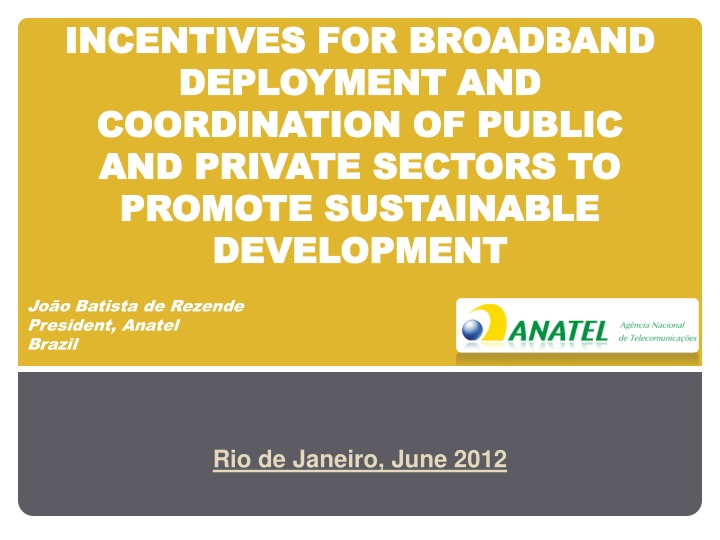

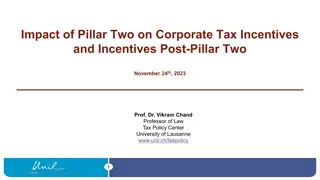
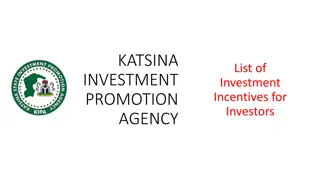
![Halal_Chicken_from_Brazil-_Ensuring_Quality_and_Authenticity[1]](/thumb/86918/halal-chicken-from-brazil-ensuring-quality-and-authenticity-1.jpg)
